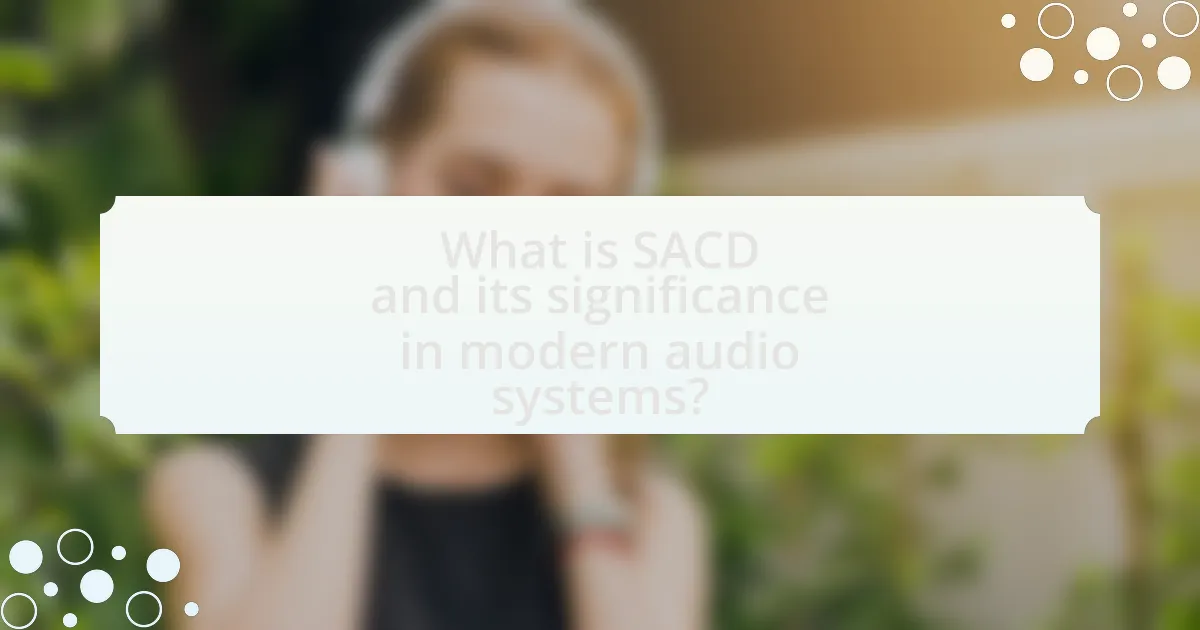SACD, or Super Audio CD, is a high-resolution audio format developed by Sony and Philips, designed to deliver superior sound quality through Direct Stream Digital (DSD) encoding. This article explores the significance of SACD in modern audio systems, highlighting its technical specifications, advantages over traditional formats, and its role in enhancing the listening experience with multi-channel audio capabilities. It also addresses the challenges SACD faces in a digital streaming-dominated landscape, including limited availability and consumer adoption, while discussing how users can maximize their SACD experience through optimal equipment and setup.
What is SACD and its significance in modern audio systems?

SACD, or Super Audio CD, is a high-resolution audio format developed by Sony and Philips, designed to provide superior sound quality compared to standard CDs. Its significance in modern audio systems lies in its ability to deliver multi-channel audio and higher sampling rates, which enhance the listening experience by offering greater detail and clarity. SACD supports both stereo and surround sound formats, making it versatile for various audio setups. The format utilizes Direct Stream Digital (DSD) encoding, which captures audio with a higher fidelity than traditional PCM formats, thus appealing to audiophiles and music enthusiasts seeking premium sound quality.
How does SACD differ from traditional audio formats?
SACD, or Super Audio CD, differs from traditional audio formats primarily in its ability to deliver higher audio quality through a different encoding method. While traditional formats like CD use Pulse Code Modulation (PCM) at a 16-bit/44.1 kHz resolution, SACD employs Direct Stream Digital (DSD) technology, which operates at a 1-bit/2.8224 MHz sampling rate. This allows SACD to capture a wider frequency range and greater dynamic range, resulting in a more detailed and immersive listening experience. Additionally, SACDs can support multi-channel audio, enhancing the spatial quality of sound compared to standard stereo formats typically found in traditional CDs.
What are the technical specifications of SACD?
The technical specifications of SACD (Super Audio CD) include a storage capacity of up to 4.7 GB for single-layer discs and 8.5 GB for dual-layer discs. SACD utilizes Direct Stream Digital (DSD) encoding, which operates at a sampling rate of 2.8224 MHz, significantly higher than the standard CD’s 44.1 kHz. This format supports multi-channel audio, allowing for up to six channels (5.1 surround sound). Additionally, SACD can also play standard CD audio, making it backward compatible. These specifications contribute to SACD’s ability to deliver high-resolution audio quality, which is a key feature in modern audio systems.
Why is SACD considered a high-resolution audio format?
SACD is considered a high-resolution audio format because it utilizes Direct Stream Digital (DSD) encoding, which offers a sampling rate of 2.8224 MHz, significantly higher than the standard CD’s 44.1 kHz. This higher sampling rate allows for a more accurate representation of audio signals, resulting in improved sound quality and detail. Additionally, SACD supports multi-channel audio, enhancing the listening experience by providing a more immersive soundstage. The combination of DSD encoding and multi-channel capabilities solidifies SACD’s status as a high-resolution audio format.
What are the key features of SACD?
The key features of SACD (Super Audio CD) include high-resolution audio playback, multi-channel sound capabilities, and a hybrid disc format. SACD supports audio sampling rates up to 2.8224 MHz, significantly higher than standard CDs, allowing for greater detail and clarity in sound reproduction. Additionally, SACD can deliver multi-channel audio, providing an immersive listening experience through formats like 5.1 surround sound. The hybrid disc format allows SACDs to be played on standard CD players, making them versatile for users who may not have SACD-compatible equipment. These features collectively enhance the audio experience, making SACD a preferred choice for audiophiles.
How does multi-channel audio enhance the listening experience?
Multi-channel audio enhances the listening experience by providing a more immersive and spatial sound environment. This technology allows sound to be distributed across multiple channels, creating a three-dimensional audio landscape that mimics real-life acoustics. Research indicates that listeners perceive greater depth and clarity in music and soundtracks when using multi-channel formats, as it enables distinct audio elements to be placed in specific locations within the sound field. For instance, a study by the Audio Engineering Society found that multi-channel audio systems can improve listener engagement and emotional response by delivering a richer auditory experience compared to traditional stereo setups.
What role does DSD (Direct Stream Digital) play in SACD?
DSD (Direct Stream Digital) serves as the primary audio encoding format for SACD (Super Audio CD), enabling high-resolution audio playback. This technology utilizes a 1-bit delta-sigma modulation process, which captures audio at a sampling rate of 2.8224 MHz, significantly higher than standard CD audio. The result is a more accurate representation of sound, providing greater detail and dynamic range. DSD’s implementation in SACD allows for the reproduction of audio that closely resembles the original recording, making it a key component in delivering superior sound quality in modern audio systems.
What are the advantages of using SACD in modern audio systems?
The advantages of using SACD in modern audio systems include superior sound quality, enhanced dynamic range, and support for multi-channel audio. SACD utilizes a higher sampling rate and bit depth compared to standard CDs, allowing for more accurate sound reproduction. Specifically, SACD employs Direct Stream Digital (DSD) technology, which captures audio at a 2.8 MHz sampling rate, significantly exceeding the 44.1 kHz of CDs. This results in a more detailed and nuanced listening experience. Additionally, SACD supports multi-channel formats, enabling immersive audio experiences that are particularly beneficial for home theater systems. The combination of these features makes SACD a preferred choice for audiophiles seeking high-fidelity sound in modern audio setups.
How does SACD improve sound quality compared to CDs?
SACD improves sound quality compared to CDs primarily through its higher resolution audio format, which supports multi-channel sound and a broader frequency range. While CDs are limited to a 16-bit depth and a sampling rate of 44.1 kHz, SACDs utilize a 1-bit DSD (Direct Stream Digital) format with a sampling rate of 2.8224 MHz, allowing for more detailed sound reproduction. This increased resolution results in a more accurate representation of the original recording, enhancing clarity and depth in audio playback. Additionally, SACD’s capability for multi-channel audio provides a more immersive listening experience, further distinguishing it from the stereo limitations of CDs.
What benefits does SACD offer for audiophiles?
SACD offers audiophiles superior sound quality through its high-resolution audio format, which supports up to 6.1 channels of audio and a sampling rate of 2.8224 MHz, significantly higher than standard CDs. This enhanced resolution allows for greater detail and clarity in music reproduction, making it particularly appealing for those who prioritize audio fidelity. Additionally, SACD’s DSD (Direct Stream Digital) encoding method minimizes distortion and preserves the nuances of the original recording, further enhancing the listening experience. The combination of these technical specifications positions SACD as a preferred choice for audiophiles seeking an immersive and high-quality audio experience.
How is SACD integrated into modern audio systems?
SACD is integrated into modern audio systems primarily through dedicated SACD players and universal disc players that support multiple formats, including SACD. These players utilize high-resolution audio capabilities, allowing for superior sound quality compared to standard CDs. Additionally, many modern AV receivers and home theater systems include HDMI inputs that can decode SACD’s DSD (Direct Stream Digital) format, enabling seamless playback through a single connection. This integration is further enhanced by the availability of SACD-compatible software and streaming services that support high-resolution audio formats, ensuring that users can access a wide range of SACD titles.
What types of players are compatible with SACD?
SACD is compatible with players specifically designed for Super Audio CD playback, including dedicated SACD players and universal disc players. Dedicated SACD players are engineered to read the high-resolution audio formats of SACD, while universal players can handle multiple formats, including SACD, CD, DVD-Audio, and others. This compatibility is essential for accessing the superior audio quality that SACD offers, which is achieved through its unique DSD (Direct Stream Digital) encoding.
How can SACD be used in home theater setups?
SACD can be used in home theater setups by providing high-resolution audio playback that enhances the overall sound quality of movies and music. SACD, or Super Audio CD, supports multi-channel audio formats, allowing for immersive surround sound experiences that are ideal for home theaters. Many modern AV receivers and players are compatible with SACD, enabling users to connect their SACD players directly to their home theater systems. This compatibility ensures that the high-fidelity audio tracks can be fully utilized, delivering superior sound clarity and depth compared to standard CDs or compressed audio formats.
What challenges does SACD face in the current audio landscape?

SACD faces significant challenges in the current audio landscape, primarily due to the dominance of streaming services and the decline in physical media sales. The rise of digital streaming platforms, which offer vast libraries of music at lower costs and with greater convenience, has led to a decrease in consumer interest in high-fidelity formats like SACD. Additionally, the limited availability of SACD players and discs in the market further restricts its accessibility to consumers. According to a report by the Recording Industry Association of America, physical music sales have been declining steadily, with digital formats capturing a larger share of the market, which underscores the difficulties SACD faces in gaining traction among modern listeners.
Why is SACD not as widely adopted as other formats?
SACD is not as widely adopted as other formats primarily due to its limited compatibility with existing audio equipment. Unlike CDs and digital downloads, which are universally supported, SACD requires specific players that can handle its high-resolution audio format. Additionally, the market for high-resolution audio has remained niche, with many consumers prioritizing convenience and accessibility over audio quality. According to a 2021 report by the Consumer Technology Association, only about 10% of households own a dedicated high-resolution audio player, indicating a lack of widespread interest. This limited consumer base, combined with the dominance of streaming services, has hindered SACD’s broader acceptance in the audio market.
What are the limitations of SACD in terms of availability and content?
SACD faces significant limitations in availability and content, primarily due to a restricted catalog and limited player options. The number of titles released on SACD is considerably smaller compared to standard CD formats, with estimates indicating that only around 5,000 SACD titles exist globally. Additionally, the production of SACD players has dwindled, making it challenging for consumers to find compatible hardware, as many mainstream audio systems do not support SACD playback. This scarcity of both content and compatible devices restricts the overall adoption and use of SACD in modern audio systems.
How does the rise of streaming services impact SACD usage?
The rise of streaming services has led to a decline in SACD usage. As streaming platforms offer high-quality audio and convenience, many consumers prefer the accessibility of digital music over physical formats like SACD. According to a report by the Recording Industry Association of America, streaming accounted for over 80% of music industry revenue in 2022, indicating a significant shift in consumer behavior away from traditional formats. This trend suggests that the demand for SACDs, which require specialized players and are less convenient, has diminished as streaming services continue to grow in popularity.
What are the future prospects for SACD?
The future prospects for SACD (Super Audio CD) appear limited but stable, primarily due to its niche market appeal and the rise of digital streaming. SACD offers high-resolution audio quality, which appeals to audiophiles, but its adoption has been constrained by the dominance of digital formats and streaming services that provide convenience and accessibility. According to a report by the International Federation of the Phonographic Industry, physical media sales have been declining, while digital music consumption continues to grow, indicating a shift in consumer preferences away from formats like SACD. Despite this, SACD maintains a dedicated following among enthusiasts and collectors, ensuring its continued production in specialized markets.
How might technological advancements influence SACD’s relevance?
Technological advancements may diminish SACD’s relevance by promoting higher-resolution audio formats and streaming services. As digital audio technology evolves, formats such as high-resolution PCM and DSD streaming become more accessible and popular, often providing superior convenience and flexibility compared to physical media like SACD. For instance, the rise of platforms like Tidal and Qobuz, which offer high-resolution audio streaming, reflects a shift in consumer preferences towards digital formats that can deliver similar or better audio quality without the need for specialized hardware. This trend indicates that as technology continues to advance, SACD may struggle to maintain its position in the modern audio landscape.
What trends are emerging in high-resolution audio formats?
Emerging trends in high-resolution audio formats include the increasing adoption of streaming services that offer high-resolution audio, such as Tidal and Qobuz, which provide lossless and high-definition audio quality. Additionally, there is a growing interest in formats like DSD (Direct Stream Digital) and MQA (Master Quality Authenticated), which are designed to deliver superior sound quality. The rise of high-resolution audio playback devices, including DACs (Digital-to-Analog Converters) and headphones that support these formats, further supports this trend. According to a report by the Consumer Technology Association, sales of high-resolution audio products have seen a significant increase, indicating a shift in consumer preference towards higher audio fidelity.
How can users maximize their SACD experience?

Users can maximize their SACD experience by utilizing high-quality playback equipment that supports SACD formats. Investing in a dedicated SACD player or a universal player that can decode SACD signals ensures optimal audio fidelity, as SACDs are designed to deliver superior sound quality through their DSD (Direct Stream Digital) encoding. Additionally, connecting the player to a high-end audio system with quality speakers and amplifiers enhances the listening experience, allowing users to appreciate the full dynamic range and detail of the music. Research indicates that SACD’s high-resolution audio capabilities can significantly improve sound quality compared to standard CDs, making the right equipment essential for an immersive experience.
What tips can enhance the playback quality of SACD?
To enhance the playback quality of SACD, use a high-quality SACD player that supports DSD (Direct Stream Digital) decoding. A dedicated SACD player ensures optimal signal processing and minimizes distortion, which is crucial for maintaining the audio fidelity that SACD offers. Additionally, connect the player to a high-fidelity audio system with quality components, including amplifiers and speakers that can accurately reproduce the wide dynamic range and frequency response of SACD recordings. Properly setting up the audio system, including speaker placement and room acoustics, further contributes to improved playback quality.
How should users set up their audio systems for optimal SACD performance?
To achieve optimal SACD performance, users should connect a dedicated SACD player to their audio system using high-quality HDMI or analog outputs. This ensures the highest fidelity in sound reproduction, as SACDs utilize a higher sampling rate and bit depth compared to standard CDs. Additionally, users should ensure their audio system supports DSD (Direct Stream Digital) playback, which is the format used by SACDs, to fully leverage the audio quality. Proper speaker placement and room acoustics should also be considered, as they significantly impact sound clarity and imaging.
What common troubleshooting steps can resolve SACD playback issues?
To resolve SACD playback issues, users should first check the compatibility of their SACD player with the disc format, as not all players support SACD playback. Next, ensuring that the SACD is clean and free from scratches can prevent playback errors. Additionally, verifying that the audio output settings on the player are correctly configured for SACD can help, as incorrect settings may lead to no sound or distorted audio. Lastly, users should confirm that the HDMI or analog connections to the audio system are secure and functioning properly, as faulty connections can disrupt playback. These steps are effective because they address common technical problems that can hinder SACD performance.

Leave a Reply